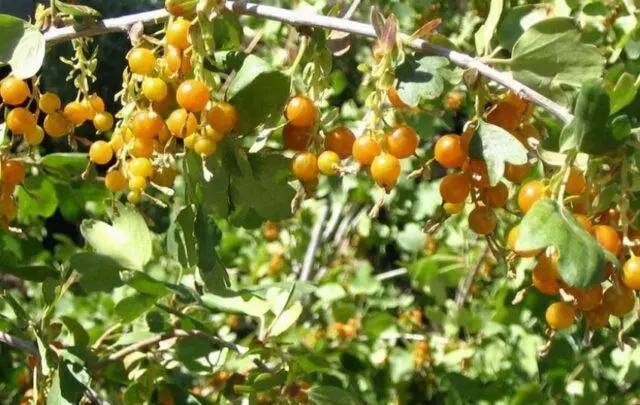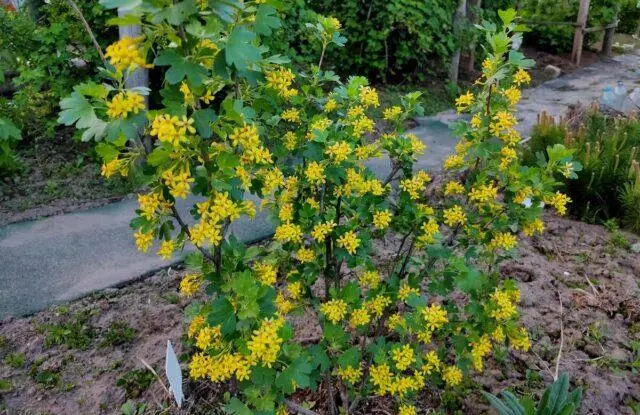Contents
Currant Laysan is a variety of selection, known for more than 20 years. Gives rather large golden-colored berries with a pleasant taste and aroma. They are used fresh and for preparations: jam, jam, fruit drink, compotes and others. Excellent as a honey plant. At the same time, the flowers cannot self-pollinate, so they need to plant several bushes.
History of breeding
Laysan is a variety of rare golden currant, bred by breeders Abdyukova N. and Abdeeva M. on the basis of the Ufa Federal Research Center of the Academy of Sciences in the mid-90s of the XX century. The variety was successfully tested and entered into the register in 1999. Approved for cultivation throughout Our Country:
- middle lane;
- Northwest;
- southern regions;
- The Urals;
- Western and Eastern Siberia;
- Far East.
Description of the variety of golden currant Laysan
Laysan currant bush is moderately sprawling, does not take up much space. The shoots are straight, strong, the surface is matte, brown in color (in young branches). Upright branches reach 2–2,5 m in length, the total height of the bush is up to 2,5 m (the culture is vigorous).
The root system is well developed, it penetrates the ground by 2 meters. Therefore, even in drought, the plants feel quite well. At the same time, a significant part of the roots is concentrated on the surface (grow horizontally), at a depth of 30–40 cm.
Leaves are medium sized, green. The surface is shiny, without pubescence, the shape is three-lobed, the cuts are deep. The bases of the leaves are straight, the notch is shallow.
Laysan currant flowers are medium in size (diameter up to 1,5 cm). The coloration is bright yellow. Each inflorescence has 5-15 flowers. A characteristic feature is a pleasant aroma. The sepals are small, brightly colored, covered with a slight layer of fluff on the outside. The ovaries are bare, rounded, no faces.
The brushes are short (2-3 cm in length), thick, each of them has 5-6 fruits. Laysan currant berries are medium in size – the mass ranges from 1,3 to 2,8 g. The shape is round, the color is yellowish-orange, golden, the surface is glossy, has a slight pubescence. The taste is balanced, with hints of sweet and sour, refreshing. The tasting was rated 4 out of 5.
Chemical composition:
- sugar (total) – 11,8%;
- acids (total) – 1,1%;
- vitamin C content: up to 70 mg per 100 g.

Laysan berries in appearance resemble gooseberries
Features
Laysan currant adapts well to different climatic conditions. The variety is high-yielding, gives tasty fruits of an interesting golden color. It tolerates heat, drought and severe frosts.
Drought resistance, winter hardiness
Currant variety Laysan is drought-resistant. In order not to lose productivity, it is recommended to increase watering up to two times a week. Winter hardiness is high, so it can be grown in most regions. Up to 12% of shoots are affected by spring frosts.
Pollination, flowering period and ripening period
Currant Laysan belongs to varieties of medium ripening. The flowering period occurs at the end of May and the first half of June (only 2-3 weeks). The fruits appear in early July.
Productivity, fruiting and keeping quality of berries
The yield of Laysan currant is 6–8,5 kg per plant (or 168 centners per hectare). Since the skin of the berries is not very strong, the keeping quality and transportability are average. The main harvest period is in the second half of July. Fruiting begins at the age of three years and reaches a peak at seven years.
Disease and pest resistance
In the description of the Laysan currant, it is indicated that the variety is not affected by pests and diseases: the plant’s immunity is quite good. However, it is impossible to completely exclude the invasion of pests, fungal, bacterial and viral infections. Therefore, in the spring, in the first half of April, it is recommended to carry out one preventive treatment with a fungicide:
- Bordeaux liquid;
- “Maksim”;
- “Topaz”;
- “Fitosporin”;
- “Hom.”
Insects can be dealt with using folk remedies, for example, a solution of laundry soap, soda, ammonia, wood ash, tobacco dust. Well help infusion of garlic cloves, onion peel, mustard powder. In extreme cases, insecticides can be used:
- “Fitoverm”;
- “Vertimek”;
- “Inta-Vir”;
- “Aktara”;
- “Confidor” and others.
In the case of the use of chemicals, the crop can be harvested only after a few days.
Advantages and disadvantages
Laysan currant is distinguished by good endurance, immunity and high yield. Unusual golden-colored berries have a marketable appearance and a pleasant, refreshing taste.

Currant Laysan gives large berries with a pleasant aroma
Pros:
- high yield;
- attractive appearance;
- decent taste;
- good immunity;
- frost resistance;
- drought tolerance;
- honey content (up to 100 kg of honey from 1 hectare);
- relatively fast maturation;
- undemanding to soil and care.
Cons:
- the crop often crumbles;
- the leaves contain poisonous hydrocyanic acid;
- bushes need pollinators.
Features of planting and care
Currant Laysan grows well on different types of soil, except for clay and marshy soils. Seedlings can be planted in mid-spring or late September – early October (a month before the first frost). When choosing a place, pay attention to the following factors:
- lighting – an area open or with a slight shadow;
- relief – better on a hill, in a lowland it is unacceptable;
- protection from the wind – optimally along the fence.
The soil for planting Laysan currants is prepared in a few months. The soil is dug up and fertilized with humus (5 kg per 1 m2) or complex mineral fertilizer (40 g per 1 m2). If the earth is clay, sawdust or sand must be embedded in it – 500 g per 1 m2.
The landing algorithm is standard:
- In a few hours, Laysan currant seedlings are immersed in a solution of Kornevin, Heteroauxin, or another growth stimulant.
- Planted at a 45 degree angle.
- Sprinkle with earth so that the root neck goes to a depth of 3-5 cm.
- A little rammed and watered with a bucket of settled water.
- Cut off all the branches, leaving 5-6 buds on each of them.
To grow healthy currant bushes of the Laysan variety, as in the photo and in the description, summer residents in their reviews recommend that you follow the basic rules of care:
- Young bushes are watered every week, adults – 2 times a month (in the heat 2 times more often).
- Fertilizers: in spring, urea or ammonium nitrate (15–20 g per 1 m2), in the summer during flowering and after harvesting they give superphosphate (40 g per 1 m2) and potassium salt (30 g per 1 m2). At the end of the season, you can pour infusion of wood ash (100 g per 10 l).
- Weeding and loosening the soil – as needed.
- Mulching for the winter with sawdust, peat, leaf litter.
- Frozen branches are removed in the spring, and formative pruning is done in the fall. Every 5 years, the bush is rejuvenated by removing the old shoots of the Laysan currant
Application in landscape design
The bushes are tall (up to 2,5 m), moderately sprawling, give bright green foliage, yellow flowers and beautiful berries of an interesting golden hue.

Currant Laysan looks self-sufficient in a single landing
Culture is often used to decorate the garden. It is grown in single plantings, as a hedge. Bushes are planted in rows along the road.
Conclusion
Currant Laysan is an unusual variety that gives golden berries with a pleasant taste and aroma. The bushes are unpretentious, tolerate drought and winter frosts well. They do not need special care, so both experienced gardeners and novice amateurs will cope with the cultivation.









